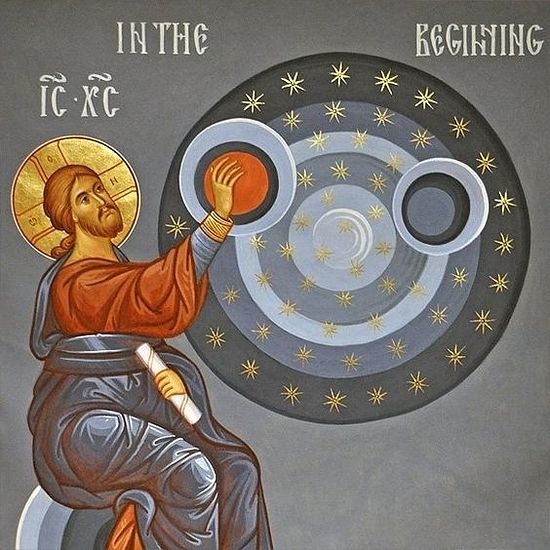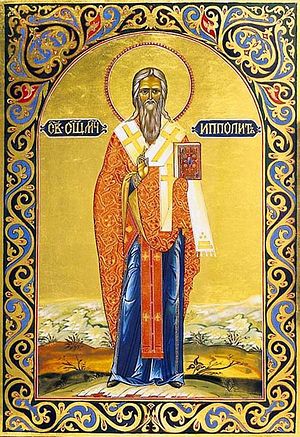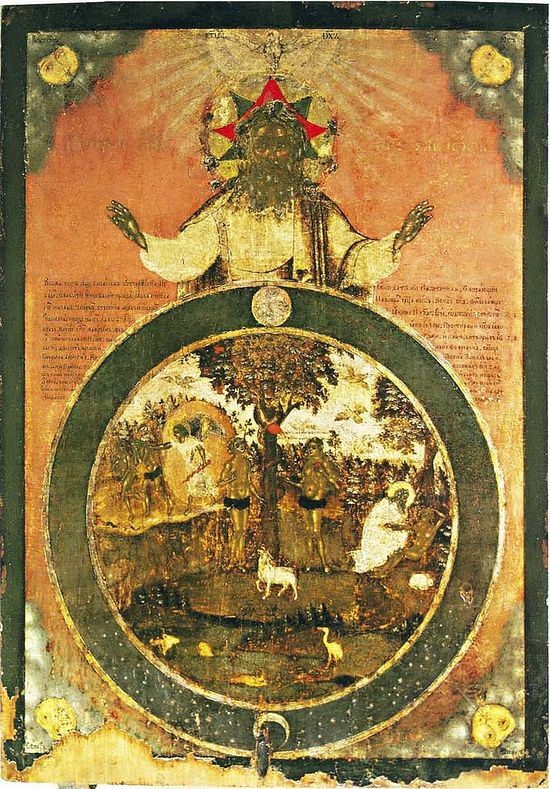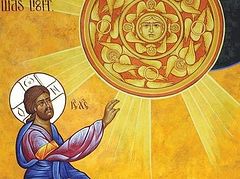According to the Church's calendar, developed during the Byzantine period and based on Biblical chronologies, September 1/14 marks the beginning of the ecclesiastical year. Specifically, September 1/14, 2016 marks the beginning of the year 7525 from the creation of the world, God having created 5509 years before the Nativity of Christ.
The article below, originally appearing on OrthodoxWiki, offers a detailed look at the development of the Church's Byzantine Creation Era calendar, and several of its predecessing calendars.
* * *
The Byzantine Creation Era, also "Creation Era of Constantinople," or "Era of the World" (Greek: Έτη Γενέσεως Κόσμου κατά 'Ρωμαίους also Έτος Κτίσεως Κόσμου or Έτος Κόσμου ) was the Calendar officially used by the Eastern Orthodox Church from ca. AD 691 to 1728 in the Ecumenical Patriarchate, by the Byzantine Empire from AD 988 to 1453, and in Russia from ca. AD 988 to 1700.
Derived from the Septuagint version of the Bible, it placed the date of creation at 5,509 years before the Incarnation, and was characterized by a certain tendency which had already been a tradition amongst Hebrews and Jews to number the years from the foundation of the world (Latin: Annus Mundi/Ab Origine Mundi [AM]).[1] Its year one, the supposed date of creation, was September 1, 5509 BC to August 31, 5508 BC.
History
It is not known who invented this era and when, however it appears for the first time in the treatise of a certain “monkand priest”, Georgios (AD 638-39), who mentions all the main variants of the "World Era" (Ére Mondiale) in his work.[2] Georgios makes it clear that the main advantage of the Byzantine era is the common starting point of the astronomical lunar and solar cycles, and of the cycle of indictions, the usual dating system in Byzantium since the sixth century. He also already regards it as the most convenient for the Easter computus. Complex calculations of the nineteen-year lunar and twenty-eight-year solar cycles within this world era allowed scholars to discover the cosmic significance of certain historical dates, such as the birth of Christ or the Crucifixion.[3]
This date underwent minor revisions before being finalized in the mid-seventh century A.D., although its precursors were developed circa AD 412. By the second half of the seventh century the Creation Era was known in the far West of Europe, in Britain.[4] By the late tenth century, around AD 988, when the Era appears in use on official government records, a unified system was widely recognized across the Eastern Roman world.
The era was ultimately calculated as starting on September 1st, and Jesus was thought to have been born in the year 5509 Annus Mundi (AM)—the year since the creation of the world.[5] Thus historical time was calculated from the creation, and not from Christ's birth, as in the west. The Eastern Church avoided the use of the Anno Domini system of Dionysius Exiguus since the date of Christ's birth was debated in Constantinople as late as the fourteenth century. Otherwise the Creation Era was identical to the Julian Calendar except that:
- the names of the months were transcribed from Latin into Greek,
- the first day of the year was September 1,[6] so that both the ecclesiastical and civil calendar years ran from September 1 to August 31, which to the present day is the Church year, and,
- the date of creation, its year one, was September 1, 5509 BC to August 31, 5508 BC.
The Byzantine World Era was gradually replaced in the Orthodox Church by the Christian Era, which was utilized initially by Patriarch Theophanes I Karykes in 1597, afterwards by Patriarch Cyril Lucaris in 1626, and then formally established by the Church in 1728.[7] Meanwhile as Russia received Orthodox Christianity from Byzantium, she inherited the Orthodox Calendar based on the Byzantine Era (translated into Slavonic). After the collapse of the Byzantine Empire in 1453, the era continued to be used by Russia, which witnessed millennialist movements in Moscow in AD 1492 (7000 AM) due to the end of the Church calendar. It was only in AD 1700 that the Byzantine Era in Russia was changed to the Julian Calendar by Peter I.[8] It still forms the basis of traditional Orthodox calendars up to today. September AD 2000 began the year 7509 AM.[9]
Earliest Christian Sources on the Age of the World
The earliest extant Christian writings on the age of the world according to the Biblical chronology are by St. Theophilus of Antioch (AD 115-181), the sixth bishop of Antioch from the Apostles, in his apologetic work To Autolycus,[10] and by Julius Africanus (AD 200-245) in his Five Books of Chronology. Both of these early Christian writers, following the Septuagint version of the Old Testament, determined the age of the world to have been about 5,530 years at the birth of Christ.[11]
Dr. Ben Zion Wacholder points out that the writings of the Church Fathers on this subject are of vital significance (even though he disagrees with their chronological system based on the authenticity of the Septuagint, as compared to that of the Hebrew text), in that through the Christian chronographers a window to the earlier Hellenistic Biblical chronographers [12]is preserved:
An immense intellectual effort was expended during the Hellenistic period by both Jews and pagans to date Creation, the flood, the exodus, the building of the Temple... In the course of their studies, men such as Tatian of Antioch (flourished in 180), Clement of Alexandria (died before 215), St. Hippolytus of Rome (died in 235), Julius Africanus of Jerusalem (died after 240), Eusebius of Caesarea in Palestine (260-340), and Pseudo-Justin frequently quoted their predecessors, the Graeco-Jewish Biblical chronographers of the Hellenistic period, thereby allowing discernment of more distant scholarship.[13]
The Hellenistic Jewish writer Demetrius the Chronographer (flourishing 221-204 B.C.) wrote On the Kings of Judea which dealt with Biblical exegesis, mainly chronology; he computed the date of the flood and the birth of Abraham exactly as in the Septuagint, and first established the Annus Adami—Era of Adam, the antecedent of the Hebrew World Era, and of the Alexandrian and Byzantine Creation Eras.
Alexandrian Era
The "Alexandrian Era" (Greek: Κόσμου ἔτη κατ’ Ἀλεξανδρεῖς ) developed in AD 412, was the precursor to the Byzantine Era. After the initial attempts by Hippolytus, Clement of Alexandria and others,[14] the Alexandrian computation of the date of creation was worked out to be March 25, 5493 BC.[15]
The Alexandrine monk Panodoros reckoned 5904 years from Adam to the year AD 412. His years began with August 29, corresponding to the First of Thoth, or the Egyptian new year.[16] Bishop Annianos of Alexandria, however, preferred the Annunciation style as New Year's Day, the 25th of March, and shifted the Panodoros era by about six months, to begin on March 25. This created the Alexandrian Era, whose first day was the first day of the proleptic[17] Alexandrian civil year in progress, August 29, 5493 BC, with the ecclesiastical year beginning on March 25, 5493 BC.
This system presents in a masterful way the mystical coincidence of the three main dates of the world's history: the beginning of Creation, the Incarnation, and the Resurrection of Christ. All these events happened, according to the Alexandrian chronology, on the 25th of March; furthermore, the first two events were separated by the period of exactly 5500 years; the first and the third one occurred on Sunday—the sacred day of the beginning of the Creation and its renovation through Christ.[18]
St. Dionysius of Alexandria had earlier emphatically quoted mystical justifications for the choice of March 25 as the start of the year:
March 25 was considered to be the anniversary of Creation itself. It was the first day of the year in the medieval Julian calendar and the nominal vernal equinox (it had been the actual equinox at the time when the Julian calendar was originally designed). Considering that Christ was conceived at that date turned March 25 into the Feast of the Annunciation which had to be followed, nine months later, by the celebration of the birth of Christ, Christmas, on December 25.
The Alexandrian Era of March 25, 5493 BC was adopted by Church Fathers such as St. Maximus the Confessor and St. Theophanes the Confessor, as well as chroniclers such as George Syncellus. Its striking mysticism made it popular in Byzantium especially in monastic circles. However, this masterpiece of Christian symbolism had two serious weak points: historical inaccuracy surrounding the date of the Resurrection as determined by its Easter computes,[19] and its contradiction to the chronology of the Gospel of St. John regarding the date of the Crucifixion on Friday after the Passover.[20]
Chronicon Paschale
A new variant of the World Era was suggested in the Chronicon Paschale, a valuable Byzantine universal chronicle of the world, composed about the year 630 AD by some representative of the Antiochian scholarly tradition.[21] It had for its basis a chronological list of events extending from the creation of Adam to the year A.D. 627. The chronology of the writer is based on the figures of the Bible and begins with March 21, 5507.
For its influence on Greek Christian chronology, and also because of its wide scope, the Chronicon Paschale takes its place beside Eusebius, and the chronicle of the monk Georgius Syncellus[22] which was so important in the Middle Ages; but in respect of form it is inferior to these works.[23]
By the late tenth century the Byzantine Era, having been fixed at September 1, 5509 BC since the mid-seventh century (differing by sixteen years from the Alexandrian date, and two years from the Chronicon Paschale), had become the widely accepted calendar of choice par excellence for Chalcedonian Orthodoxy.
Accounts in Church Fathers
St. John Chrysostom
St. John Chrysostom says clearly in his Homily "On the Cross and the Thief", that Christ:
"opened for us today Paradise, which had remained closed for some 5000 years.”[24]
St. Isaac the Syrian
St. Isaac the Syrian writes in a Homily that before Christ:
"For five thousand years five hundred and some years God left Adam (i.e. man) to labor on the earth.”[25]
St. Augustine
Blessed Augustine writes in the City of God (written AD 413-426):
"Let us omit the conjectures of men who know not what they say, when they speak of the nature and origin of the human race...They are deceived by those highly mendacious documents which profess to give the history of many thousands of years, though reckoning by the sacred writings we find that not 6,000 years have passed.”[26]
Augustine goes on to say that the ancient Greek chronology "does not exceed the true account of the duration of the world as it is given in our documents (i.e. the Scriptures), which are truly sacred."
St. Hippolytus
St. Hippolytus of Rome (ca.170-235) maintained on Scriptural grounds that the Lord's birth took place in 5500 AM, and held that the birth of Christ took place on a Passover day, deducing that its date was March 25. He gave the following intervals:
"...from Adam to the flood 2242 years, thence to Abraham 1141 years, thence to the Exodus 430 years, thence to the passover of Joshua 41 years, thence to the passover of Hezekiah 864 years, thence to the passover of Josiah 114 years, thence to the passover of Ezra 107 years, and thence to the birth of Christ 563 years.”
In his Commentary on Daniel, one of his earlier writings, he proceeds to set out additional reasons for accepting the date of 5500 AM:
First he quotes Exod. xxv. 10f. and pointing out that the length, breadth and height of the ark of the covenant amount in all to 5 1/2 cubits, says that these symbolize the 5,500 years from Adam at the end of which the Saviour was born. He then quotes from Jn. xix. 14 'it was about the sixth hour ' and, understanding by that 5 1/2 hours, takes each hour to correspond to a thousand years of the world's life...[27]
Around AD 202 Hippolytus held that the Lord was born in the forty-second year of the reign of Augustus[28] and that he was born in 5500AM. In his Commentary on Daniel he did not need to establish the precise year of the Lord's birth; he is not concerned about the day of the week, the month-date, or even the year; it was sufficient for his purpose to show that Christ was born in the days of Augustus in 5500 AM.
Quinisext Council
It is referred to indirectly in Canon III of the Quinisext Council, which the Orthodox Churches consider as ecumenical, its canons being added to the decrees of the Fifth and Sixth Councils, as follows:
"... as of the fifteenth day of the month of January last past, in the last fourth indiction, in the year six thousand one hundred and ninety [6190]...”
Accounts in Byzantine Authors
From Justinian's decree in AD 537 that all dates must include the Indiction, the unification of the theological date of Creation (as yet unfinalized) with the administrative system of Indiction cycles became commonly referred to amongst Byzantine authors, to whom the Indiction was the standard measurement of time.
In Official Documents
As mentioned above, in the year AD 691 we find the Creation Era in the Acts of the Trullanum Council (so‐called Synodos Quinisexta).
We find the era also in the dating of the so-called Letter of three Patriarchs to the emperor Theophilos (April, indiction 14, 6344=836 AD).
By the tenth century the Byzantine Era is found in the Novellas of A.D. 947, 962, 964, and most surely of the year A.D. 988, all dated in this way, as well as the Act of Patriarch Nicholaos II Chrysobergos in A.D. 987.[29]
John Skylitzes
John Skylitzes' (ca.1081-1118) major work is the Synopsis of Histories, which covers the reigns of the Byzantine emperors from the death of Nicephorus I in 811 to the deposition of Michael IV in 1057; it continues the chronicle of St. Theophanes the Confessor. Quoting from him as an example of the common Byzantine dating method, he refers to emperor Basil, writing that:
"In the year 6508 [1000], in the thirteenth indiction, the emperor sent a great force against the Bulgarian fortified positions (kastra) on the far side of the Balkan (Haimos) mountains..."[30]
Niketas Choniates
Niketas Choniates (ca. 1155–1215), sometimes called Acominatus, was a Byzantine Greek historian. His chief work is his History, in twenty-one books, of the period from 1118 to 1207. Again, an example of the dating method can be seen as he refers to the fall of Constantinople to the Fourth Crusade as follows:
"The queen of cities fell to the Latins on the twelfth day of the month of April of the seventh indiction in the year 6712 [1204]."[31]
Doukas
The historian Doukas, writing circa AD 1460, makes a detailed account of the Creation Era. Although unrefined in style, the history of Doukas is both judicious and trustworthy, and it is the most valuable source for the closing years of the Byzantine empire:
From Adam, the first man created by God, to Noah, at whose time the flood took place, there were ten generations. The first, which was from God, was that of Adam. The second, after 230 years, was that of Seth begotten of Adam. The third, 205 years after Seth, was that of Enos begotten of Seth. The fourth, 190 years after Enos, was that of Kainan begotten of Enos. The fifth, 170 years after Kainan, was that of Mahaleel begotten of Kainan. The sixth, 165 years after Mahaleel, was that of Jared begotten of Mahaleel. The seventh, 162 years after Jared, was that of Enoch begotten of Jared. The eighth, 165 years after Enoch, was that of Methuselah begotten of Enoch. The ninth, 167 years after Methuselah, was that of Lamech begotten of Methuselah. The tenth, 188 years after Lamech, was that of Noah. Noah was 600 years old when the flood of water came upon the earth. Thus 2242 years may be counted from Adam to the flood.
There are also ten generations from the flood to Abraham numbering 1121 years. Abraham was seventy-five years old when he moved to the land of Canaan from Mesopotamia, and having resided there twenty-five years he begat Isaac. Isaac begat two sons, Esau and Jacob. When Jacob was 130 years old he went to Egypt with his twelve sons and grandchildren, seventy-five in number. And Abraham with his offspring dwelt in the land of Canaan 433 years, and having multiplied they numbered twelve tribes; a multitude of 600,000 were reckoned from the twelve sons of Jacob whose names are as follows: Ruben, Symeon, Levi, Judah, Issachar, Zebulun, Naphtali, Gad, Asher, Dan, Joseph, and Benjamin.
The descendants of Levi were Moses and Aaron; the latter was the first of the priesthood while Moses was appointed to govern. In the eightieth year of his life he walked through the Red Sea and led his people out of Egypt. This Moses flourished in the time of Inachos [son of Oceanus and King of Argos] who was the first [Greek] king to reign. Thus the Jews are more ancient than the Greeks.
Remaining in the wilderness forty years they were governed for twenty-five years by Joshua, son of Nun, and by the Judges for 454 years to the reign of Saul, the first king installed by them. During the first year of his reign the great David was born. Thus from Abraham to David fourteen generations are numbered for a total of 1024 years. From David to the deportation to Babylon [586 BC] there are fourteen generations totalling 609 years. From the Babylonian Captivity to Christ there are fourteen generations totalling 504 years.
By the sequence of Numbers we calculate the number of 5,500 years from the time of the first Adam to Christ."[32]
The Byzantine Mindset
Literal Creation Days
Even the most mystical Fathers such as St. Isaac the Syrian accepted without question the common understanding of the Church that the world was created "more or less" in 5,500 BC. As Fr. Seraphim Rose points out:
The Holy Fathers (probably unanimously) certainly have no doubt that the chronology of the Old Testament, from Adam onwards, is to be accepted "literally." They did not have the fundamentalist's over-concern for chronological precision, but even the most mystical Fathers (St. Isaac the Syrian, St. Gregory Palamas, etc.) were quite certain that Adam lived literally some 900 years, that there were some 5,500 years ("more or less") between the creation and the Birth of Christ.[33]
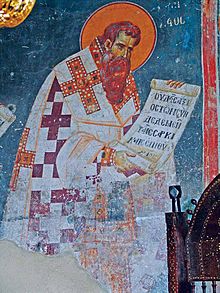 St. Basil the Great
St. Basil the Great "Thus then, if it is said, In the beginning God created, it is to teach us that at the will of God the world arose in less than an instant..."
Typical of the Christian conviction on this point, St. Hilary of Poitiers also affirms that the Creation was performed ex nihilo:
"For all things, as the Prophet says, were made out of nothing; it was no transformation of existing things, but the creation of the non-being into a perfect form.”[35]
The prophet cited by St. Hilary was the mother of the Maccabean martyrs, who said to one of her tortured sons, I beseech you, my child, to look at heaven and earth and see everything in them, and know that God made them out of nothing; so also He made the race of man in this way" (2 Maccabees 7:28). This text from 2 Maccabees was the standard Biblical prooftext for the Christian Church in respect to creation from nothingness. We find the thesis in late Judaism, from which it passed into the Christian faith as an essential teaching.[36]
In addition, the traditional Jewish understanding of the creation "days" of Genesis is that they are literal as well, as virtually all the Rabbis have understood in commentaries from Talmudic, Midrashic and Rabbinic sources.[37]
Hours of the Liturgical Day
In the Byzantine period the day was divided into two twelve-hour cycles, fixed by the rising and setting of the sun.
Following Roman custom, the Byzantines began their calendrical day (nychthemeron) at midnight with the first hour of day (hemera) coming at dawn. The third hour marked midmorning, the sixth hour noon, and the ninth hour midafternoon. Evening (hespera) began at the eleventh hour, and with sunset came the first hour of night (apodeipnon). The interval between sunset and sunrise (nyx) was similarly divided into twelve hours as well as the traditional "watches" (vigiliae) of Roman times.[38]
Days of the Liturgical Week
Dr. Marcus Rautman points out that the seven-day week was known throughout the ancient world. The Roman Calendar had assigned one of the planetary deities to each day of the week. The Byzantines naturally avoided using these Latin names with their pagan echoes. They began their week with the "Lord's Day" (Kyriake), followed by an orderly succession of numbered days (Deutera, Trite, Tetarte, and Pempte), a day of "preparation" (Paraskeve), and finally Sabatton.
Each day was devoted to remembering one or more martyrs or saints, whose observed feast days gradually eclipsed traditional festivals. Kyriake was seen as both the first and eighth day of the week, in the same way that Christ was the Alpha and Omega of the cosmos, existing both before and after time. The second day of the week recognized angels, "the secondary luminaries as the first reflections of the primal outpouring of light," just as the sun and the moon had been observed during the Roman week. John the Baptist, the Forerunner (Prodromos) of Christ, was honored on the third day. Both the second and third days were viewed as occasions for penitence. The fourth and sixth days were dedicated to the Cross with holy songs sung in remembrance of the Crucifixion. The Virgin Mary was honored on the fifth day of the week, while the seventh day was set aside for the martyrs of the church.[39]
Comparative List of Dates of Creation
Early Church Writers
- 5537 BC[40]—Julius Africanus (AD 200-245), Church historian.
- 5529 BC[41]—St. Theophilus (AD 115-181), bishop of Antioch.
- 5509 BC—Byzantine Creation Era or "Creation Era of Constantinople." (finalized in mid-seventh c. AD).
- 5507 BC—Chronicon Paschale (ca. AD 630), Byzantine universal chronicle of the world.
- 5500 BC—St. Hippolytus of Rome. (ca. AD 234), presbyter, writer, martyr.
- 5493 BC—Alexandrian Era (AD 412).
- 5199 BC—Eusebius of Caesarea, bishop of Caesarea and Church historian (AD 324).
Later Estimates
- 5199 BC—Mentioned in the Roman Martyrology,[42] published by the authority of Pope Gregory XIII in 1584, later confirmed in 1630 under Pope Urban VIII.
- 4963 BC—According to the Benedictine Chronology,[43] which is founded on the LXX,[44] the Creation of Adam is given this date (AD 1750).
- 4004 BC[45]—Anglican Archbishop James Ussher (AD 1650).
- 3952 BC—Venerable Bede (ca. AD 725), English Benedictine monk.
- 3761 BC[46]—Hebrew Calendar [Judaism]—(ca. AD 222-276); or, (ca. AD 358—Hillel World Era).
- 3760 BC[47]—Era of Adam, starts with creation of Adam. This era was used prior to the Hillel Era.
Summary
As the Greek and Roman methods of computing time were connected with certain pagan rites and observances, Christians began at an early period to adopt the Hebrew practice of reckoning their years from the supposed period of the Creation of the world.[48]
Currently the two dominant dates for Creation that exist using the Biblical model are about 5500 BC and about 4000 BC. These are calculated from the genealogies in two versions of the Bible, with most of the difference arising from two versions of Genesis. The older dates of the Church Fathers in the Byzantine Era and in its precursor, the Alexandrian Era, are based on the Greek Septuagint. The later dates of Archbishop James Ussher and the Hebrew Calendar are based on the Hebrew Masoretic text.
The Fathers were well aware of the discrepancy of some hundreds of years between the Greek and Hebrew Old Testament chronology,[49] and it did not bother them; they did not quibble over years or worry that the standard calendar was precise "to the very year;” it is sufficient that what is involved is beyond any doubt a matter of some few thousands of years, involving the lifetimes of specific men, and it can in no way be interpreted as millions of years or whole ages and races of men.[50]
To this day, traditional Orthodox Christians will use the Byzantine calculation of the World Era in conjunction with the Anno Domini (AD) year. Both dates appear on Orthodox cornerstones, ecclesiastical calendars and formal documents. The ecclesiastical new year is still observed on September 1 (or on the Gregorian Calendar's September 14 for those Churches which follow the Julian Calendar). September 2016 marks the beginning of the year 7525 of this era.

